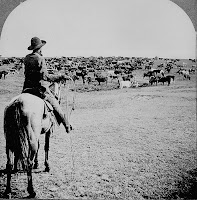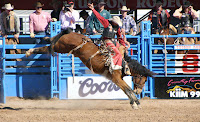The Ranches of Texas
One of the things that Texas is well known for is it's ranches. The size of the state itself lends it perfectly to the industry of cattle raising and the huge King Ranch ( larger than the state of Rhode Island) in south Texas is a prime example. It's also a very interesting place to visit when your Texas vacation takes you the south Texas between Corpus Christie and the Mexican border. Next to the King Ranch Texas the XIT Ranch in the opposite part of the state is a lasting part of Texas history. In fact, it was the establishment of the XIT that made the construction of today's Texas state capitol possible. The XIT story and it's 3 million acres was the largest in it's time. The King Ranch came into existence about 25 years before the XIT. The King Ranch was at one time the world's largest ranch and famous for breeding livestock, the Santa Gertrudis type of cattle which are shorthorn cows of a southern beef breed. They were named for the Spanish land grant where Captain Richard King built the King Ranch. One of the amazing things about the King Ranch aside from it's massive size (it is divided into four divisions) is the way it came about and the man who made it happen.
Today's King Ranch
 |
| Cattle Roundup, Courtesy U.S.D.A. |
Another great place to visit at the ranch is The "King Ranch Saddle Shop". It's one of the most unique shops of it's kind. Lot's of items that reflect the history of the King Ranch. Household items, clothing, and "ranch stuff". Captain Richard King was unsuccessful in locating quality saddles and leather goods locally and as a result established his own saddle shop more than 150 years ago for the use of his ranch employees. There was actually King Ranch Leather and the King Ranch Saddle. Among customers of the Saddle Shop have been heads of states and kings. The King Ranch Saddle Shop is located at 201 East Kleberg Ave., Kingsville Texas.
To demonstrate how the King Ranch name has stayed popular during these modern times, those wishing a culinary treat can prepare The King Ranch Casserole. The King Ranch may be the only working ranch that has it's name on Ford trucks. One popular model remains the King Ranch F150 from Ford Motor Company. Another is the El King Ranch Expedition model.
 |
| Cattle herd,Cowboy,circa 1902 |
You'll also enjoy our article on the History of Cowboys.
Richard King
The life of the man who founded the King Ranch is nothing short of a classic rags to riches story. Richard King was born in New York City in 1824 to poor Irish immigrant parents. At eleven years of age his parents set him up as a jewelers apprentice. The intention was that young Richard would learn this trade but the reality was that the young boy was ordered by the jeweler to do everyday chores, not learning the trade which the boy wasn't excited about to begin with. As Richard King later stated, the jewelers apprentice did cleaning, fetching and scrubbing and he had enough. At the age of eleven the boy ran away from home and New York.
 |
| Bronco Rider, Courtesy Joekoz451 |
The method chosen to escape was as a stowaway on the sailing ship Desdemona which was headed to Mobile Alabama. The boy was discovered hiding among the cargo but made it to Mobile nevertheless. The young Richard King got himself a job as a steamboat cabin boy and moved up from there. From that position to "cub" pilot and from that to full steamboat pilot. There was no formal education. What he learned came from his job and travels. When the Mexican-American war erupted in 1846, King who by then was a licensed steamboat pilot in New Orleans, joined the United States service as a pilot and served running men and supplies on the Rio Grande until the war ended.
In 1850, King, a long time steamboat friend Mifflin Kenedy and two other partners formed the M. Kenedy and Company steamboat firm. In 1866 the two other partners were bought out and the company was renamed the King-Kenedy Company. This steamboat firm had almost total control of Rio Grande steamboat shipping.
Richard King had traveled from the Brownsville Texas area north to Corpus Christie to attend a fair and during this trip he caught notice of all the land that to him seemed excellent for grazing. He was pretty well acquainted with cattle during his service in Texas during the war. In 1853 and 1854 King buying up land near the Nueces Strip area and began forming the King Ranch. King continued to add land to his ranch all the way until he died in 1885. At his death there was a total of 614,000 acres.
Take our Fun Short History Quiz on our Trips Into History site.
History Quiz
The Civil War and Richard King
 |
| American cowboy, circa 1888 |
In all respects, Richard King was a very important Confederate agent. His involvement didn't come without risks. Three days before Christmas in 1863, King had been alerted that a contingent of Union soldiers were headed to the unprotected ranch to arrest him. King saddled a horse and set off for Mexico. When the troops arrived at the ranch there was a lot of shooting and the ranch house was essentially ransacked. The Union forces caused a great deal of damage and drove off all the cattle they could round up. They were frustrated when they learned that the person they shot and killed near the door who they suspected was King actually was a ranch hand. A few months later Richards Kings wife, children and father traveled to San Patricio to live. In February of that year she gave birth to a boy who was named Robert E. Lee King.At the war's conclusion Richard King was given amnesty and a full presidential pardon and was able to rejoin his family.
Operating the Famous King Ranch
Another interesting story about the King Ranch has to do with all of the money that had to be transported in running an operation it's size. Richard King was known to be armed with a shotgun along with armed men on many trips away from the ranch. Often he found himself traveling with large amounts of money, sometimes as much as $50,000 for purposes of meeting payroll and/or buying additional land. He built a steel box inside his coach where the money was hidden. King's office manager and his wife Henrietta were the only people who knew about the box. Amazingly, in light of the remote areas King traveled, he was never robbed or successfully ambushed.
King managed costs by in effect selling his herd to the various trail bosses who were his employees. The bosses would sign a note for the cattle they would leave with on a three month drive each February. Upon the sale of the herd to the northern buyers, the trail bosses would repay King and earn a profit that was larger than their ordinary pay. It was an arrangement that worked well for all involved.
Some personal facts about the riverboat captain turned cattle baron. Richard King obviously became a very wealthy man. King had investments in everything from ice houses to waterfront construction in Corpus Christie. The story is that King would hand out $5, $10 or $20 notes to those who he deemed in need. He was also known to have donated to specific efforts taken on by the Texas Rangers, the statewide law enforcement group. There has also been statements that he was a land grabber but research shows that King purchased his land fair and square using lawyers to complete the process.
King ultimately split up his partnership with Kenedy but continued to operate his King Ranch. It was widely believed that the untimely death of his youngest son, Lee King, while at college in Kansas pretty much put the father in a depression and that he never really had the same enthusiasm afterward. Captain Richard King passed away in April 1885 at the Menger Hotel in San Antonio Texas. He was 60 years of age. The last surviving family member, the founder's great-great grandson left the operation in 1997 although at the time the ranch was a large corporation, King Ranch, Inc. with it's president the Houston oilman Jack Hunt.
 |
| Kingsville's Kenedy County,TX |
Another very interesting story about ranches and cattlemen that occurred around Buffalo Wyoming in 1892 is the Johnson County War.

